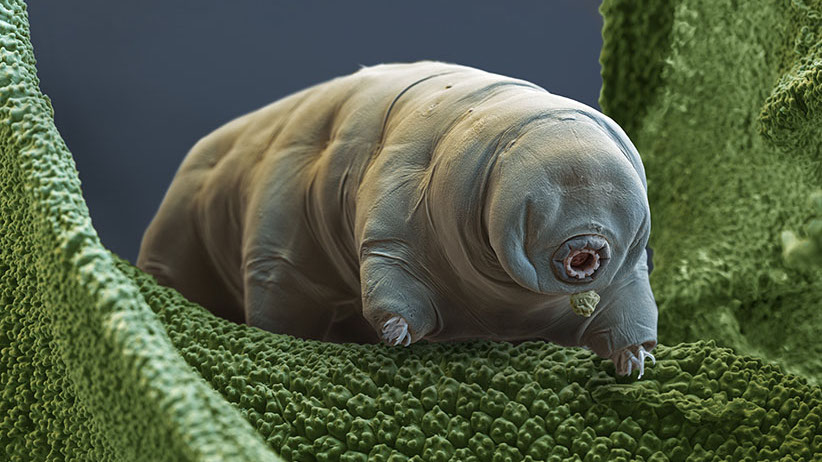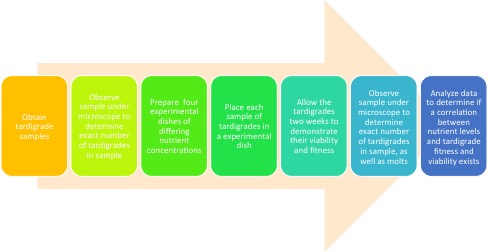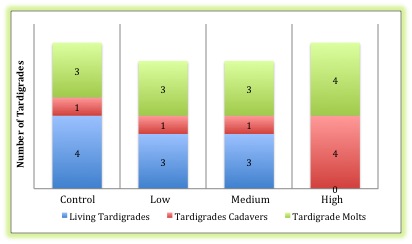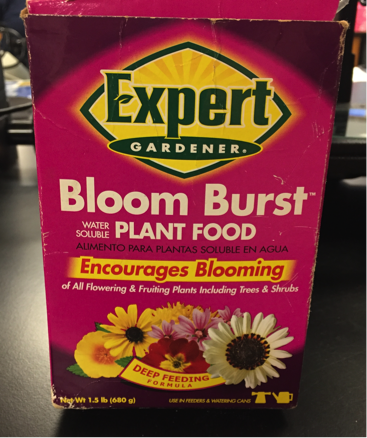The Effects of Nutrient Concentrations upon Tardigrade Fitness
by Chandler Johnson
The aim of this study is to evaluate the impact of an increasing nutrient-concentration gradient on the viability and fitness of the resilient eight-legged, segmented, microscopic animals known as tardigrades, Hypsibius dujardini. The nutrient-rich solutions, which contain a mixture of mostly nitrogen, phosphate, and potash, are composed of what is marketed as a plant fertilizer: ‘Expert Gardener Bloom Burst Water Soluble Plant Food.’ The experiment was conducted by placing equal amounts of tardigrades (4 tardigrades) in each of the three experimental dishes, (and 5 tardigrades in the one controlled nutrient-concentration dish), containing varying nutrient concentrations. By counting the number of living tardigrades, molts, and potential offspring after the experiment was completed, an evaluation of possible correlations between tardigrade viability and fitness, and nutrient concentration was conducted. The concentrations were of 0.0 µg/mL (control), 10,110.0 µg/mL, 101.1 µg/mL, and 50.55 µg/mL. Results depicted that there is a correlation between increased nutrient concentration and tardigrade viability: at the highest nutrient concentration all tardigrades died, whereas in the control, at concentration, only one of the tardigrades died. These findings are meaningful in that they show that increasing the concentration of nutrients within the environment has dire implications for even the most resilient forms of life.
Introduction
As the global population continues to grow exponentially, the demand for a consistent and reliable food supply has become increasingly critical. In fact, over the course of the past fifty years, the human global population has doubled, and the food availability per capita has increased accordingly.1 In order to keep up with the enormous demand for agricultural products, the so-called ‘Green Revolution’ has exhibited a marked dependence upon synthetic fertilizers. These synthetic fertilizers oftentimes contain critical levels of nitrogen (N), phosphorus (P), and potassium (K)1 that help to ensure viable harvests.
When land is intensively farmed, as is common practice in countries where the population is increasing rapidly, adequately productive harvests necessitate the use of synthetic fertilizers. These have been shown to lead to ecological degradation. Eutrophication, the proliferation of nutrients, within water sources from agricultural runoff is a common result of the ecological degradation resulting from agricultural impacts. In fact, eutrophication is one of the key factors in determining an environment’s ecological quality—even more so than toxic substances, in some cases.2 It is reported that the phosphorus enrichment in a tested Dutch environment caused greater ecological damage in surface waters than exposure to toxic substances.2
Tardigrades are known to inhabit marine, estuarine, freshwater, and terrestrial ecosystems.3 Tardigrades are nearly omnipresent in the terrestrial and aquatic environments that are adjacent to agricultural lands. Tardigrades have potential to serve as important biological indicators of environmental health. Furthermore, different groups of nematodes, of which tardigrades are included, show sensitivities to the disturbance of soil composition due to agricultural management.4 These animals possess a permeable cuticle that surrounds their body, leaving them exposed to compounds that have dissolved in the surrounding environment in which they inhabit.4
The permeable cuticle that surrounds the tardigrade guarantees that these animals are at a high risk for the influx of harmful compounds into their system.
Figure 1: Image of a terrestrial tardigrade5

A terrestrial tardigrade is pictured at a magnification of 400x.
In Southern Spain, a study was conducted to monitor the effects of soil fumigation on agroecosystem function. It was preformed through an evaluation of soil nematode diversity. The results showed that soil fumigation resulted in a permanently disturbed nematode population.4 Rather than nutrient concentration, as was the focus of this experiment, the before mentioned study focused upon the presence of pesticides composed of the compounds 1,3-dichloropropene and chloropicrin, which were shown to have a significant negative effect on nematode diversity.4 Through the results of this study, it can be understood that despite their resilience to environmental stressors, tardigrades are not invulnerable: they have the potential to suffer high mortality rates in conditions that are unfavorable to support tardigrade life due to their permeable cuticle.
However, tardigrades are known for their ability to withstand extreme environments due to their morphology, as well as evolutionary life history adaptations that contribute to their survival. Shown to be of particular interest to researchers is the phenomenon of crypotobiosis, of which there are many forms—evolving in a manner that reflects the extreme environment in which a particular population of tardigrades resides. In the case of aquatic tardigrades (those which were the subject of this experiment), the ability to undergo cryptobiosis is rare, or nonexistent.3 Therefore, when observing tardigrades in a state of suspended animation, it was noted in this experiment that the tardigrades were not in a cryptobiotic state (in which they would be referred to as tuns,6 but were lifeless.
Interestingly, cryptobiosis has been hypothesized to correlate to tardigrades’ fluid osmolality, which is regulated by an internal ion-retentive mechanism.7 An experiment evaluating the ion concentration of five different species of tardigrades through use of a Metrohm chromatography system showed that the ions found in highest concentration in the internal fluids of the tardigrades were Na+ and Cl– as well as K+, NH+4, Ca2+, Mg2+, F–, SO2–4, PO3–4.7 Furthermore, these internal ion concentrations, regulated by an internal ion-retentive mechanism, are not only present within tardigrades that can undergo cryptobiosis, but also within those that were tested in this experiment, Hypsibius dujardini. Therefore, this experiment has the potential to be explanatory in the capability of the ion regulating mechanism, particularly in regards to phosphate regulation, which is a main component of the prepared nutrient solutions, as well as the internal fluid of tardigrades.
The goal of this experiment is to evaluate the impact of increased nutrient concentrations on the viability and fitness of tardigrades. The term fitness within the context of this experiment refers to a population’s ability to maintain or increase population size in following generations.8 Through interpretation of collected data, the objective is to gain a deeper understanding of the impact of eutrophication on a micro-ecological scale. Then subsequently apply that knowledge to inform ecological best management practices for agricultural use of nutrients contained in fertilizers.
Methods
The experiment began by obtaining a sample of tardigrades from the Ward Company, with code number WARD470180-260; it was a 30/35 Student Unit sample of the Hypsibius (water bears, or tardigrades). This sample of tardigrades was divided into four separate petri dishes: one control sample and three test samples, with differing nutrient concentrations. After diving up the tardigrades amongst the petri dishes, dish one contained five living tardigrades; dish two contained four living tardigrades; dish three contained four living tardigrades; and dish four contained four living tardigrades. Each petri dish, hereafter referred to as an experimental dish, contained 10 mL solution of dilute alfalfa media, tardigrades, and their nutrient supply (Spirogyra). After these experimental dishes were created, the process of creating the varying concentrations of nutrient enriched water began.
Three different concentrations of nutrient enriched water were prepared to go in three of the four experimental dishes—one of the four, the control, did not receive nutrient enriched water. The three different concentrations of nutrient enriched water were prepared by adding specific masses of solute to specific volumes of solvent. The solvent was spring water. The solute is Expert Gardener Bloom Burst Water Soluble Plant Food, with the main active ingredients of nitrogen (10%), phosphate (52%), and potash (10%). The concentrations created were designed to mimic those similar to the concentrations of nutrients found in runoff; to give perspective limit instilled on the runoff from agricultural fields lists 1 mg/L, i.e. .001 g/L as the maximum amount.9 Therefore, the concentrations were: 0.01011 g/mL (high concentration), 0.0001011 g/mL (medium concentration), and 0.00005055 g/mL (low concentration).
Upon placing the tardigrades in the respective experimental dishes, they were left for two weeks to allow them to exhibit their relative fitness, as well as their viability under the environmental conditions they were exposed to. Upon the conclusion of the experiment, the four different experimental dishes were evaluated to determine the amount of living tardigrades, dead tardigrades, and molts that were evident.
Fig 2: An outline of the experimental procedure used to conduct the experiment observing the effects of nutrient concentrations upon tardigrade fitness

Results and Discussion
At the beginning of the experiment, there were five living tardigrades in the first dish, control dish; four tardigrades in the second dish (low nutrient concentration); four tardigrades in the third dish (medium nutrient concentration); and four tardigrades in the fourth dish (high nutrient concentration). All of these tardigrades were determined to be alive at the starting time of the experiment. Furthermore, there were no molts present at the starting time of the experiment.
Fig 3: Initial amount of tardigrades present in each experimental dish
| Control | Low nutrient concentration | Medium nutrient concentration | High nutrient concentration |
| 5 living tardigrades | 4 living tardigrades | 4 living tardigrades | 4 living tardigrades |
At the beginning of the experiment, there were five living tardigrades place in the control dish, and four living tardigrades placed in the three remaining experimental dishes. To ensure standardization of the experiment, and to give an accurate representation of tardigrade viability, the number of tardigrades initially added was kept equal in the experimental dishes.
After the two week trial time, giving the tardigrades adequate time to reproduce and demonstrate their ability to respond to their environmental conditions, the following data was obtained. Dish one (control) produced: four living tardigrades, one dead tardigrade, and three molts. Dish two (low nutrient concentration) produced three living tardigrades, one dead tardigrade, and three molts. Dish three (medium nutrient concentration) produced three living tardigrades, one dead tardigrade, and three molts. Dish four (high nutrient concentration) produced zero living tardigrades, four dead tardigrades, and four molts. It is necessary to include the fact that tardigrade mortality was based solely on locomotion—if tardigrades were observed not moving after being watched for a period of at least ten minutes, they were deemed to be dead. It was proposed that the tardigrades exhibiting locomotion could be in a cryptobiotic state; however, this is highly unlikely because the tardigrade sample used in this experiment is one that is advertised as containing tardigrades unable to undergo cryptobiosis. In addition, tardigrade molts were associated with the unmoving, transparent tardigrades. These specimens may contain tardigrade eggs, not capable of being observed by the level of magnification used for the course of the experiment.
Fig 4: Tardigrade population present after two weeks
| Tardigrade Status | Dish 1 (Control) | Dish 2 (Low) | Dish 3 (Medium) | Dish 4 (High) |
| Living | 4 | 3 | 3 | 0 |
| Dead | 1 | 1 | 1 | 4 |
| Molts | 3 | 3 | 3 | 4 |
At the conclusion of the experiment, after two weeks of testing has been conducted, the profile of living and dead tardigrades confirmed the hypothesized results: there were higher mortality rates in the experimental dishes that had greater nutrient concentrations.
Figure 5: Comparative representation of the tardigrade population after two weeks, at the conclusion of the experiment
At the beginning of the experiment, there were five living tardigrades added to the control dish; at the conclusion of the experiment, four were living, and one was dead. The control dish, as can be observed above, represents the dish in which there was the highest survival rate. The low and medium concentration dishes yielded the same results: of the four living tardigrades added to each experiment, three survived and one died in each of the dishes. The high concentration dish yielded the highest mortality: of the four tardigrades added to the dish initially, all four had died at the experiment’s conclusion. Furthermore, each of the experimental dishes yield molts ranging from 3—4.
Upon evaluating the data obtained through experimental processes, it was determined that there is a correlation between increasing nutrient concentration and the viability of tardigrade population. Fitness could not be determined due to an inability to definitively identify tardigrade eggs. This understanding of a correlation comes from a comparison of the relative mortality rates in each of the four populations under analysis. For the control group, 20% of the tardigrades, 1/5 tardigrade, died. For groups two and three, which represent low and medium concentrations of nutrient-enriched water, 25% of the tardigrades, 1/4 tardigrades died, showing an increase in mortality. Lastly, in the fourth group, which represents a high concentration of nutrient-enriched solution, 100% of the tardigrades died, 4/4 tardigrades. From this data, it is clear that even the most common of synthetic plant fertilizers, such as the Expert Bloom Bust Plant Food used in this experiment, have the potential to have a adverse biological effects.
Figure 6: Image of the popular ‘plant food’ mixture used to create nutrient-rich solutions taken by author
The solute used is this experiment is Expert Gardener Bloom Burst Water Soluble Plant Food, with the main active ingredients of nitrogen (10%), phosphate (52%), and potash (10%).
It is to be noted that there could be a correlation between the mortality of tardigrades, and the evidence that molting had occurred. In specific, when tardigrades have molted, they are without a highly developed cuticle, and are more exposed to the ions of their surrounding environment. In fact, it is has been determined through research conducted by S.D. Van Gundy that the presence of a cuticle in a mature nematode, as well as an egg membrane in a developing tardigrade, is crucial for the survival of the organism in adverse environmental conditions.10 In this experiment, molts were found in each of the experimental dishes, and each of the experimental dishes contained at least one dead tardigrade. Furthermore, in the high concentration experimental dish, four molts were found, along with four dead tardigrades. Due to the fact that there were more ions—to a level that was potentially toxic—in the high concentration dish, it is plausible that these contributed to the higher mortality rate of the tardigrades. However, to confirm this speculated correlation, further tests must be performed.
In this experiment, there are various sources of error that must be considered along with the findings it yielded. It must be acknowledged that the length of trial was quite short in relation to the life span of a tardigrade, which can range three months, to far longer—if it can initiate a cryptobiotic state. The limitations placed on this experiment were due to it being conducted in a biology laboratory class setting where brevity and economy were deemed paramount. For the results to be considered more reliable, a longer experiment must be performed in order to allocate necessary time for tardigrades to proceed through their life cycle. Furthermore, the sample size on which the experiment was performed was small: seventeen in total. For the experiment results to be more dependable, a larger sample size must be used. The results do seem to be valid despite the small sample size because a logical clear pattern was observed.
Further research should be conducted in order to confirm the obtained results, using a larger sample size, and longer experiment duration. In addition, implementing technologies that aid in the identification of the exact point in the lifecycle and tardigrade in a given sample is in, would be beneficial in understanding its cuticle composition, and therefore its ion permeability. Also, studies identifying the particular ion concentrations most strongly correlated with tardigrade mortality could aid in identifying particular fertilizer constituents that are most lethal to tardigrades.
Although this experiment was performed on a small scale, using a very small sample size, the results clearly illustrate a potential correlation between increasing ion concentration, from a fertilizer source, and tardigrade mortality. As Huang (2013) attested to in his research pertaining to the use of biological indicators in the restoration of a river ecosystem, biological indicators are important in the information they offer about the health of particular environment, and how it may be improved.11 In conclusion, this study implies that tardigrades have the potential to serve as important biological indicators. In fact, they may aid in the detection of environments that require intervention in response to detrimental human practices such as the overuse of fertilizers.
References
1Elser, James J. Regime Shift In Fertilizer Commodities Indicates More Turbulence Ahead For Food Security. Food Science Source. (2016).
2Struijs, J. Characterization Factors For Inland Water Eutrophication At The Damage Level In Life Cycle Impact Assessment. International Journal Of Life Cycle Assessment 16.1. (2011).
3Nelson, Diane R. Current Status of the Tardigrada: Evolution and Ecology. Integrative and Comparative Biology 652. (2002)
4Carrascosa, M, S Sanchez-Moreno, and JL Alonso-Prados. Relationships Between Nematode Diversity, Plant Biomass, Nutrient Cycling And Soil Suppressiveness In Fumigated Soils. European Journal Of Soil Biology 62. (n.d.).
5Gulli, Cathy. “Even 30 years of deep freeze can’t stop the water bear.” http://www.macleans.ca/society/science/even-30-years-of-deep-freeze-cant-stop-the-water-bear/. (2016)
6“Water Bear.” Funk & Wagnalls New World Encyclopedia (2016)
7Halberg, Kenneth Agerlin. Inorganic Ion Composition In Tardigrada: Cryptobionts Contain A Large Fraction Of Unidentified Organic Solutes. Journal Of Experimental Biology 216.7. (2013).
8Fitness. http://www.dictionary.com/browse/fitness. (2016).
9Ortega-Achury, SL. Nutrient Concentrations In Runoff From Different Manure Amended Fields Of The Tropics Under Natural Rainfall Conditions. Journal Of Agriculture Of The University Of Puerto Rico 91.3-4. (n.d.).
10Van Gundy, S. D. Factors In Survival Of Nematodes. Annual Review Of Phytopathology 3. (1965
11Huang, Wei. Application Of Analytic Hierarchy Process In Selecting A Biological Indicator For A River Flow Restoration. Ecological Indicators 25. (2013).
Chandler Elizabeth Johnson, from Rome, Georgia, is a third year student of the Franklin College at the University of Georgia. Based in Athens, Georgia during the academic year, she spends her time pursuing degrees in Biochemistry and Spanish while conducting research through the Genetics and Forestry Departments. Her interest in the sciences is deeply rooted in her passion for the outdoors; when not engaged in academic endeavors, she works to promote the stewardship of the National Parks. Her current research interests are on the SUC5/SUC6 sucrose symporters and their role in phloem loading, as well as their impact on the release of exudate at the extrafloral nectaries of Populus tremula × Populus tremuloides (Ptt).
Acknowledgments: I would like to express my great appreciation to my biology lab partners: Mary Kingsley, Quinn Roe, and Adir Mohaban. Without the creativity and insight that each of you brought to the group, this experiment could not have been as successful as it was. Also, to our lab teaching assistant Amy Styer—thank you for your never-ending patience and willingness to problem solve with my group when unforeseen complications with our experiment arose. To my readers: I hope you enjoy reading about my experiment as much as I enjoyed conducting it.
Citation style: Nature Reference Style


